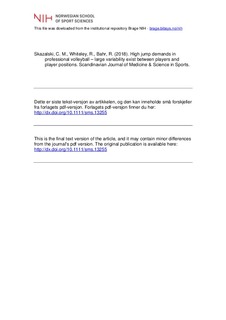| dc.contributor.author | Skazalski, Christopher | |
| dc.contributor.author | Whiteley, Rod | |
| dc.contributor.author | Bahr, Roald | |
| dc.date.accessioned | 2019-06-28T12:37:58Z | |
| dc.date.available | 2019-06-28T12:37:58Z | |
| dc.date.created | 2018-07-03T13:53:40Z | |
| dc.date.issued | 2018 | |
| dc.identifier.citation | Scandinavian Journal of Medicine & Science in Sports. 2018, . | nb_NO |
| dc.identifier.issn | 0905-7188 | |
| dc.identifier.uri | http://hdl.handle.net/11250/2602829 | |
| dc.description | I Brage finner du siste tekst-versjon av artikkelen, og den kan inneholde ubetydelige forskjeller fra forlagets pdf-versjon. Forlagets pdf-versjon finner du på onlinelibrary.wiley.com / In Brage you'll find the final text version of the article, and it may contain insignificant differences from the journal's pdf version. The definitive version is available at onlinelibrary.wiley.com | nb_NO |
| dc.description.abstract | Purpose: Training volume has been associated with jumper's knee in volleyball players, but jump variability among professionals has not been investigated and individual jump demands are unknown. The purpose of this study was to examine position‐specific jump demands required for training and competition during a professional volleyball season and to investigate the individual variability associated with jump load. Methods: Jumps performed by 14 professional players during one season of training and competition were timestamped, individually assigned, and recorded for jump height. Jump counts, heights, and frequency were analyzed to determine the specific jump load performed by players at each position during training and match play. Results: A total of 129,173 jumps were performed during 142 sessions (108 practices, 27 matches, 7 friendly matches). Setters performed the greatest volume of jumps (121 jumps/training session). Opposites performed more high intensity jumps than their teammates (median season jump height: 69% of maximum). Substantial weekly jump count variability was observed, 18 of 28 weeks included at least one player with a 2‐fold increase in jump load or a player returning to volleyball after performing no jumps the previous week. Additionally, each player had at least one week with a 2‐fold increase in jumps. Conclusion: Jump demands are high in professional volleyball and performance programs should be tailored to the match and training demands required at each position. Jump loads are highly variable – substantial week‐to‐week increases were observed for both the team and individual players. As a result, monitoring individual jump load seems necessary. | nb_NO |
| dc.language.iso | eng | nb_NO |
| dc.subject | injury prevention | nb_NO |
| dc.subject | jump load | nb_NO |
| dc.subject | load monitoring | nb_NO |
| dc.subject | vert | nb_NO |
| dc.subject | volleyball | nb_NO |
| dc.subject | workload | nb_NO |
| dc.title | High jump demands in professional volleyball – large variability exists between players and player positions | nb_NO |
| dc.title.alternative | High jump demands in professional volleyball – large variability exists between players and player positions | nb_NO |
| dc.type | Journal article | nb_NO |
| dc.type | Peer reviewed | nb_NO |
| dc.description.version | acceptedVersion | nb_NO |
| dc.source.pagenumber | 15 | nb_NO |
| dc.source.journal | Scandinavian Journal of Medicine & Science in Sports | nb_NO |
| dc.identifier.doi | 10.1111/sms.13255 | |
| dc.identifier.cristin | 1595447 | |
| dc.description.localcode | Seksjon for idrettsmedisinske fag / Department of Sports Medicine | nb_NO |
| cristin.unitcode | 150,34,0,0 | |
| cristin.unitname | Seksjon for idrettsmedisinske fag | |
| cristin.ispublished | true | |
| cristin.fulltext | postprint | |
| cristin.qualitycode | 2 | |
